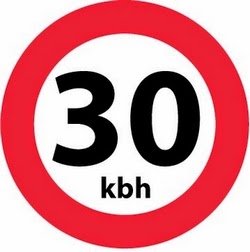
Yeah, so I woke up to some promising news this morning here in Copenhagen. For all the modern liveable city goodness in the Danish capital, we are in the Bronze Age regarding speed limits in cities.
It's been lonely being one of the only people broadcasting the need for 30 km/h zones in Danish cities. Discovering that modernisation may be on the way is fantastic. The first 30 km/h zone was implemented in 1983 in Buxtehude, Germany. Over 150 cities in Europe have made 30 km/h the default speed in urban areas.
It is shocking that most of densely-populated Copenhagen isn't already a 30 km/h zone.
 Buxtehude, Germany. 1983.
Buxtehude, Germany. 1983.
In Denmark, the Ministry of Justice published a document back in 1985 with the sexy name
Justitsministeriets cirkulære nr. 72 af 5. juli 1985 making it possible for municipalities to adjust local speed limits. If "
speed is a major cause of accident or risk on the stretch in question".
While that sounds like a good thing, they stated that it had to be proven that a reduction in speed would make dangerous stretches safer. Proving it has been a difficult task and the proof had to be in the form of complicated mathematical calculations. Weird to require calculations in order to save human lives, reduce injuries and make cities nicer. The next challenge was convincing the police to allow it. As we've written about before, the Danish police have bizarre powers and veto rights regarding traffic and they are not obliged to provide proof to support their veto.
The
police in Copenhagen wouldn't even agree to 40 km/h zones, let alone the European Union standard of 30.
Today, however, the Ministry of Justice has announced that they are working on making it easier for municipalities to reduce speed limits. Let's hope they don't overcomplicate it and that they complete ignore the police on the subject. Until it's time to enforce the new speed limits. THEN they can move in and do their job.
We have written at length about 30 km/h zones here on the blog and we started
a little Facebook group called 30 kbh (kbh is the short form for København - Copenhagen in Danish).

You can read
30 km/h Zones Work.
We also made an analysis of the effectiveness of 30 km/h zones that is freely downloadable and sharable. But here's the gist of it all:
30 zones reduce injury and death
A study carried out in London concluded that there was a 42% reduction in injuries after the implementation of 30 km/h zones. Younger children were the group with the most significant reduction in KSI’s (Killed & Seriously Injured). A 27% reduction was measured in Barcelona, which led to the city rolling out massive 30 km/h zones across the urban landscape.

The numbers are pretty clear here. If you get hit by a car doing 30 km/h your chance of dying is only 5%. At 50 km/h it is 50%.

As your speed increases in a car, your peripheral vision decreases drastically.
There is no cheaper or more effective way to save lives and reduce injury in cities. Period.
30 zones improve congestion
With slower speeds, the amount of stop-starts is reduced – if not eliminated – which improves flow and helps easy congestion.
30 zones are inexpensive
Changing speed limit signs is inexpensive while building out sidewalks and narrowing lane widths is more expensive. Nevertheless, it is cost efficient. In Switzerland, the annual savings on health costs due to 30 zones is €120 - €130 million.
30 zones reduce noise pollution
By reducing the speed by 10 km/h, a noise reduction of 2-3 dB is achieved. That is far cheaper than noise reducing asphalt.
Read more in the article Noisy Danish Speed Demons.
Also, the noise of five cars at 50 km/h is the same as ten cars at 30 km/h. The noise of one large truck equals as much noise as 15 cars.
30 zones improve air quality
In an overall analysis of pollutants, 30 km/h zones reduce CO2 emissions by 15%, NOX emissions by 40% and CO emissions by 45%. Only hydrocarbons will increase, by 4%.
30 zones improve fuel efficiency
Since they improve flow, motorists will save on fuel and reduce C02 emissions.
30 zones improve local business
The traffic calming effect that 30 km/h zones have on neighbourhoods is remarkable. Pedestrians and cyclists increase and, since pedestrians and cyclists spend more money in shops, local business benefits. A study in the UK showed that people who walked to town centres spent an average of £91 (around €115) per week, while motorists would spent £64 (around €80) per week.
Cyclists, too, are proven to spend more money in shops than motorists.









